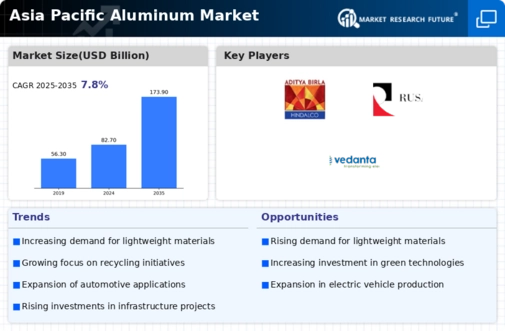Market Analysis
In-depth Analysis of Asia Pacific Aluminum Market Industry Landscape
Influenced by various factors such as industrial demand and geopolitical considerations, this dynamic landscape of the Asia Pacific Aluminum Market has emerged. China is a key driver of market trends in this region which has become the world hub for aluminum production and consumption. The growth of construction, automotive, packaging and electronics industries is one of the main drivers of APAC aluminum market. Due to its lightweight and corrosion-resistant properties, aluminum is largely preferred across these sectors in addition to creating stable demand dynamics throughout the market.
Similarly, government initiatives and policies have a significant impact on the Asia Pacific Aluminum Market. Many countries in this area have undertaken infrastructure development projects that require large amounts of aluminium especially for construction purposes. Governments are also encouraging companies to use aluminium instead of other metals due to its recyclability and ability to reduce environmental pollution. This shift towards ecological sustainability redefines market behavior preferences for environmentally friendly materials.
China dominates both production and consumption of aluminium hence playing a pivotal role in influencing market dynamics within Asia Pacific region. It is not only largest consumer but also a major producer whose activities contribute to both regional and global supply chains. When there are changes in economic policies, environmental regulations or trade patterns within China that affects prices or availability of Aluminium products in the Asia-Pacific region can be highly anticipated. In terms of cleaner production methods, Chinese government priorities influence adoption with support from more efficient recycling facilities.
Another factor affecting dynamics within the Asia Pacific Aluminum Market is volatility (which refers) caused by price fluctuations in global markets. Global aluminium prices fluctuate due to elements like political crises among nations, dictatorial policies leading to trading setbacks as well as alterations made on currency exchange rates which consequently affect cost structure for businesses operating within this area specifically those based on manufacturing goods thus making them meet their entrepreneurial ends through appropriate strategic decision making.
On top of that; innovation coupled with technological advancements cannot be left out whenever we talk about shaping market conditions here at APAC aluminum sector. Through continuous research and developments, new uses are found for aluminum as well as improved methods of manufacturing it. For instance, lightweighting trends in the automotive industry and aerospace sectors are driving demand for high-strength aluminum alloys. These innovative approaches to aluminium’s application do not only multiply its utilization across industries but also help expand markets by meeting changing demands.
This recycling landscape is a key market dynamic in the Asia Pacific Aluminum Market. Aluminium recycling has gained momentum due to increase focus on circular economy and sustainable practices. Governments and industries have been investing on recycling capacities while consumers have increased awareness on benefits associated with the use of recycled aluminium. This trend is influencing the market dynamics by creating a more circular and eco-friendly approach to aluminium production and consumption.
Within market dynamics, there can be issues related to overcapacity or trade tensions. Overcapacity concerns arise when too much supply has led to depressed prices within global aluminum markets therefore impacting their profitability negatively especially for producers affected by these fluctuations particularly from China perspective. Like all other businesses, Aluminum products both being regional or international can be affected by trade disputes hence disrupting normal flow of goods thus changing market dynamics due to uncertainties related to tariffs, quotas and export bans that may be imposed.






Leave a Comment